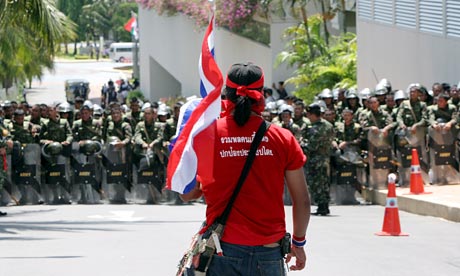The April-June 2010 edition of the East Asia Forum Quarterly, which I guest edited, includes three articles about Thailand. They each point to the deep-seated frustrations and long-term political conflicts that motivate the Red Shirt protest movement.
A few months ago when academic analysts Thitinan Pongsudhirak and Kevin Hewison, and photo-journalist Nick Nostitz, were preparing their articles for the East Asia Forum Quarterly none of us could fully anticipate the bloodshed and strife that would mark the month of May 2010. But trends over many years indicate that Thai society has become deeply divided without consensual mechanisms for resolving its social conflicts. Those conflicts help explain why the past month has been so tortuous for Thailand, and why the immediate prognosis for the country has slipped from ‘bad’ to ‘worse’.
Are the Red Shirts to blame?
The Red Shirts (or, in more formal terms, the United Front for Democracy against Dictatorship) grew out of the formidable, and successful, political machine associated with former Prime Minister Thaksin Shinawatra. Revitalised and refinanced a few times since the coup of September 2006 unseated their notional figurehead, the Reds now define one fraction of Thailand’s colour-coded political landscape.
Their protests have been inspired by calls for an end to the current government and resignation of Prime Minister Abhisit Vejjajiva. The Red Shirts hope to see the reinstitution of a democratic culture that they feel has been illegally usurped.
In recent months much of their activism has been devoted to demanding an electoral system that will, they expect, see victory for their side in future democratic contests. This should not be taken to mean that any future victory for the Red Shirts would see a return of Thaksin, but it could represent a return to the principles that informed Thailand’s electoral culture after the implementation of the 1997 constitution.
That implementation was clearly a mixed bag. Thaksin’s unflinching ambition and will to dominate national life was an unforeseen outcome of a system which, the theory went, should have continued the long tradition of weak, coalition governments. Thaksin’s super majorities, his human rights abuses, and his competition with other patronage arrangements, especially the one controlled by the palace, motivated dissent. It is that dissent which culminated in the 2006 coup.
It is also a similar strain of dissent that helps explain why many Red Shirts are dissatisfied with Thaksin and his close lieutenants, particularly with how Thaksin has continued to hijack what some see as a movement designed to capture the spirit of Thailand’s ‘true democracy’.
The risks to both former Prime Minister Thaksin and the supporters of Prime Minister Abhisit become clearest when we consider the possibility that neither figurehead is palatable any longer.
While the Red Shirts may temporarily dissipate in the wake of the recent crackdown, the political claims and agendas that they represent will not simply melt away. New generations have become politically active, old wounds have been re-opened, and tired certainties look as flimsy as ever.
Many analysts agree that at the next election, whenever that might be, it is very likely that a political party from the Red side will garner enough votes to form a coalition and govern Thailand. Trepidation about the implications of such a victory is one reason that elections are currently off the agenda.
Instead, a dangerous cycle of political turmoil might continue until a new consensus is reached about national political institutions.
Such a consensus struggles for priority while King Bhumibol Adulyadej remains on the throne. The accumulated accomplishments and failures of his almost 64-year reign weigh heavily on a society that has long struggled to find an institutional balance that does not simply preserve palace and military prerogatives.
Now that parts of the royal family are deeply, and publicly, embroiled in political events there is even less room for open intervention by the king. Indeed whatever interventions have been made are likely to have taken place behind closed doors and palace walls. Preparing for succession, and jostling for position as future ‘king makers’, is likely a major part of this unfolding story.
Now, in the waning years of King Bhumibol’s reign, Thailand is a fractured society. It requires a new deal between those who feel disenfranchised by current politics and those elements of the Bangkok elite that fear a return of Thaksin’s patronage machine. It is, ultimately, in the preparations for a fresh consensus, once King Bhumibol is no longer on the throne, that the most optimistic prognosis for Thailand can be entertained.
Thailand will remain starkly divided without new conversations about the future of the monarchy, the military and the political system’s inter-locking patronage arrangements. Now that blood has been shed, buildings burned and the chimera of unity exposed, the country faces a very long road back to normality and compromise.
Nicholas Farrelly is a Southeast Asia specialist in the ANU’s College of Asia and the Pacific. He is the co-founder of New Mandala and is a regular commentator on Thai affairs.

